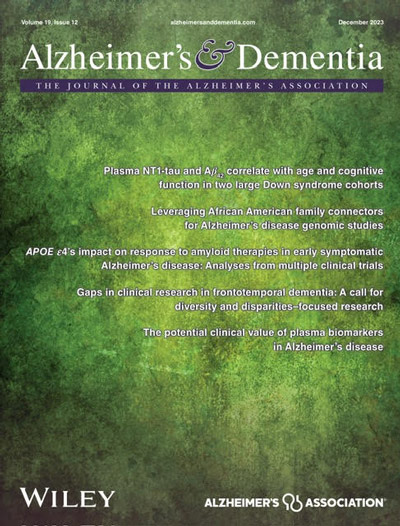基于血液的阿尔茨海默病生物标志物精确测量的循证标准化样本处理方案:全球生物标志物标准化联盟的结果和共识。
IF 11.1
1区 医学
Q1 CLINICAL NEUROLOGY
引用次数: 0
摘要
基于血液的生物标志物(BBMs)已经彻底改变了阿尔茨海默病的诊断和监测。它们在分析前的稳定性需要仔细审查。本研究评估了分析前的影响,以制定标准化的样品处理方案。方法评估分析前差异包括收集管类型、溶血、离心设置、离心/储存延迟、试管转移和冻融(n = 15/实验)。磷酸化tau (pTau)亚型采用Simoa、Lumipulse、MesoScale Discovery和免疫沉淀-质谱法测定。用Simoa法测定淀粉样蛋白(Aβ42、Aβ40)、胶质纤维酸性蛋白(GFAP)和神经丝光蛋白(NfL)。结果不同收集管类型的BBM水平差异均在10%以上。其中,Aβ肽最为敏感,在贮藏和离心延迟条件下,Aβ肽水平下降了10%以上,在室温(RT)条件下比在2 ~ 8℃条件下下降幅度更大。在RT/-20°C贮藏时,NfL和GFAP水平增加了10%以上。pTau亚型在大多数分析前变异中表现出稳定性。我们建立了一个基于证据的处理方案,以确保在临床、试验和研究中采用神经学脑卒中的可靠样本处理。样品处理方案可以减轻分析前对BBM结果的影响。我们制定了一套以证据为基础、专家共识的血浆样本处理方案。主收集管和延迟到离心或冷冻影响AD BBMs。等离子体pTau217对分析前样品处理变化具有很强的抵抗力。血浆Aβ42和Aβ40对分析前变异最为敏感。本文章由计算机程序翻译,如有差异,请以英文原文为准。
Evidence-based standardized sample handling protocol for accurate blood-based Alzheimer's disease biomarker measurement: Results and consensus of the Global Biomarker Standardization Consortium.
INTRODUCTION
Blood-based biomarkers (BBMs) have revolutionized Alzheimer's disease diagnosis and monitoring. Their pre-analytical stability requires scrutiny. This study assessed pre-analytical effects to inform a standardized sample handling protocol.
METHODS
Assessed pre-analytical variations included collection tube type, hemolysis, centrifugation settings, centrifugation/storage delays, tube transfers, and freeze-thawing (n = 15/experiment). Phosphorylated tau (pTau) isoforms were measured with Simoa, Lumipulse, MesoScale Discovery, and immunoprecipitation-mass spectrometry. Amyloid-beta (Aβ42, Aβ40), glial fibrillary acidic protein (GFAP), and neurofilament light (NfL) protein were measured with Simoa.
RESULTS
All assessed BBM levels varied by over 10% by collection tube type. Aβ peptides were the most sensitive, and their levels declined >by more than 10% under storage and centrifugation delays, more steeply at room temperature (RT) compared with 2°C to 8°C. NfL and GFAP levels increased by more than 10% upon RT/-20°C storage. pTau isoforms demonstrated stability across most pre-analytical variations.
DISCUSSION
We established an evidence-based handling protocol to ensure reliable sample handling for neurological BBMs upon adoption in clinics, trials, and research.
HIGHLIGHTS
Sample handling protocols can mitigate pre-analytical effects on BBM results. We developed an evidence-based, expert-consensus plasma sample handling protocol. Primary collection tube and delays to centrifuging or freezing impact AD BBMs. Plasma pTau217 is highly resistant to pre-analytical sample handling variations. Plasma Aβ42 and Aβ40 were most sensitive to pre-analytical variations.
求助全文
通过发布文献求助,成功后即可免费获取论文全文。
去求助
来源期刊

Alzheimer's & Dementia
医学-临床神经学
CiteScore
14.50
自引率
5.00%
发文量
299
审稿时长
3 months
期刊介绍:
Alzheimer's & Dementia is a peer-reviewed journal that aims to bridge knowledge gaps in dementia research by covering the entire spectrum, from basic science to clinical trials to social and behavioral investigations. It provides a platform for rapid communication of new findings and ideas, optimal translation of research into practical applications, increasing knowledge across diverse disciplines for early detection, diagnosis, and intervention, and identifying promising new research directions. In July 2008, Alzheimer's & Dementia was accepted for indexing by MEDLINE, recognizing its scientific merit and contribution to Alzheimer's research.
 求助内容:
求助内容: 应助结果提醒方式:
应助结果提醒方式:


